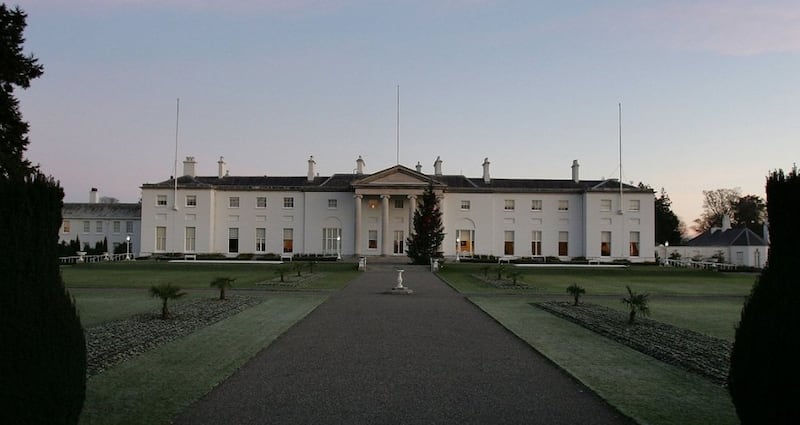As the woeful presidential election campaign drew to its inevitable conclusion at the weekend, journalists scrambled for what the “real” story of the result was. Was it Peter Casey’s surprising leap into second place and what that means for political discourse in Ireland? Or was the real story to ignore that and focus on the emphatic victory of Michael D Higgins?
Was the real story what could happen if a more sophisticated and charismatic candidate came along with Casey’s rhetoric more palatably packaged? Maybe not, as Trump-like candidates don’t need the aesthetic of the centre or the marketing and communications slickness of the establishment. The whole point is that they thumb their noses at that.
The strength of angry, bar-stool ranters and “golf club bores” as Casey was described, is that they remain angry and unpolished, frustrating those of us who favour intellect and political pleasantries. Would the Healy-Raes do as well if they hired a crack marketing team who prettied them up? Hardly. Such a communications strategy would be incongruous to the strength of their message and personalities, as infuriating as those can be.

Repeatedly ignored
But there’s another “real” story being forgotten, and that’s Donegal, with an electorate that keeps shouting for attention at the ballot box, with rarely anyone listening. At some point the country is going to have to pay attention to a county that is repeatedly ignored, and address the economic and social issues that neglect has caused.
Donegal had the second-lowest turnout in the country, at 33.74 per cent, with Dublin Central fairing the worst at 31.78 per cent. Casey received 12,952 votes in Donegal, Higgins got 15,052. Casey got 20,149 votes in Tipperary to Higgins’s 24,917. Both counties are centres of anti-establishment voting patterns. Tipperary is where Michael Lowry tops the poll and Mattie McGrath comes second.
Donegal was the sole constituency to vote against the repeal of the Eighth Amendment, with 51.87 per cent. Before the constituency boundary change, it was among the highest No votes in the marriage equality referendum, with Donegal South-West voting 49.95 per cent No, and Donegal North-East 47.54 per cent, averaging a No vote of 48.75 per cent, second only to Cavan-Monaghan (49.35 per cent) and the sole No-voting constituency, Roscommon-South Leitrim (51.42 per cent.)
To encapsulate Donegal’s isolation, the tale of its rail system is often told. Donegal once had the longest narrow-gauge railway system in the country, which by 1960 was dismantled. This infrastructure and its removal remains a sense of both nostalgic pride and a symbol of neglect and being wronged by those who make decisions about the county far away from it.
In an article for Irish Central last year, the journalist Cahir O’Doherty wrote: “We in Donegal would find ourselves politically decapitated, as two centuries of developing trade and commerce links were suddenly cut, collateral damage in a wider political redistricting. Because of our isolation I’ve always thought of Co Donegal as Ireland’s orphan county, or as a sort of phantom limb, a land surrendered figuratively and literally by both the Republic and Northern Ireland.”
The 2016 census showed that the unemployment rate in Donegal was a massive 18 per cent. Earlier this year, Joe McHugh trumpeted the positive news of the unemployment rate in Donegal dropping by 43 per cent between January 2012 and January 2018, but it was dropping from a height. The results of the 2011 census showed the unemployment rate in Donegal at that time was colossal – 26.2 per cent, comparable to Greece in the run-up to its bailout referendum in 2015.
Emigration
The decrease of the live register number is also to do with emigration that plagues Donegal. The county’s population decreased by 1.5 per cent between 2011 and 2016, which sounds small, but when you compare it with the only other two counties that experienced an average decline in population – Mayo (-0.1 per cent) and Sligo (-0.2 per cent) – it’s seriously significant. Of course, there are plenty more people from Donegal, and a lot of them are living in Dublin and Perth and Sydney and Auckland and London. In 2016, the vacancy rate of houses in Donegal stood at 27.4 per cent, with nearly 23,000 out of nearly 84,000 uninhabited.
And what impact Brexit – the economic equivalent of an aircraft flying into a mountain – will have on Donegal? When we talk about the Border, I don’t think Donegal is the first thing conjured in people’s minds. Yet the county’s border runs along Tyrone, Derry and Fermanagh, with only a slip of a border with Leitrim. If we think Donegal is cut off now, what will happen then? If Casey runs for a Dáil seat anywhere, it’ll be in Donegal. But while he may ruminate about running there, voters in Donegal might ruminate too. For an already isolated and wrongfully neglected county, what good has it done and would it do for Donegal to elect anti-establishment politicians?
Donegal has it all. It is primed to succeed. It has the best beaches in the country. It has an arts and culture scene brimming with brilliance and eccentricities. It has a landscape tourists would lose their minds over if enough of them ever went up there. Then it goes to the polls and goes against the tide. The central government and media in Dublin take a glance, maybe even an eye roll, and then forget about it again, until next time. And that’s simply not good enough.











